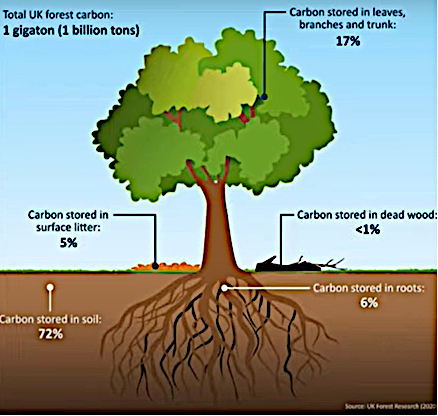
|
Why We Plant Trees Our knowledge of the importance of trees and ancient forests to the environment has been advancing by leaps and bounds over the past decade. It is not just the forested areas or numbers of trees in total which matters, but how many species are mixed up together and how mixed in their ages. Trees are categorised into two groups: those in woodlands and those outside woodlands - in towns, villages, and fields. In total, trees cover only 13% of the UK land area, but it’s 10% in England, compared to an average of 35% in Europe. If the UK is to reach its carbon neutral target by 2050 it needs to raise its tree cover from 13% to 19% - and that was before this winter’s storms; Arwen, Dudley, Eunice and Franklin toppled another estimated four million trees in England alone. However, in a new change of policy, where possible, most of the latest fallen trees will be left to degenerate where they fell, to provide natural habitats for wildlife. Trees are the ultimate carbon capture and storage machines. Like great carbon sinks, woods and forests absorb atmospheric carbon and lock it up for centuries. They do this through photosynthesis. |
 |
|
But, it is not just the trees; the entire woodland ecosystem plays its
role in locking up carbon. Apart from the tree visible above ground, the
roots systems grow downwards and draw down carbon nutrients to feed the
surrounding soil. Leaf debris and deadwood also break down and feed into
the soil.
A handful of soil contains hundreds of worms and other species
constantly enriching it further. Trees provide homes for birds, small
mammals, and hundreds more different bug species, and the whole
bio-diverse habitat of the forest can expand as new trees are added.
Trees also help fight climate change in other ways. They prevent
flooding, reduce pollution, and they reduce city temperatures.
An amazing scientific discovery has also emerged from the giant ancient forests of North America. The tree species in these forests do not compete with one other for sunlight and under-ground nutrients, as scientists and agro-forestry experts had always assumed. Instead, they cooperate. We now know they communicate with one another intelligently. The forest floor is alive with networks of different fungal species which warn of harmful disease, boosting immunity. They supply different nutrients to young saplings, to help them grow strongly in the shaded areas alongside older ones, and the very oldest trees, the ‘mother trees’, can donate their own internal structure to where it is most needed, as they themselves begin to decompose and die. Young trees need constant water which older trees take from the soil and pass to them, while in times of plenty, larger trees feed all their water deep back into the soil. The forests share a beneficent wisdom. They possess an awesome collective intelligence. Reference:
Finding the Mother Tree by Suzanne Simard
|